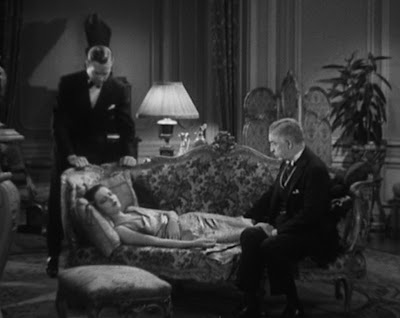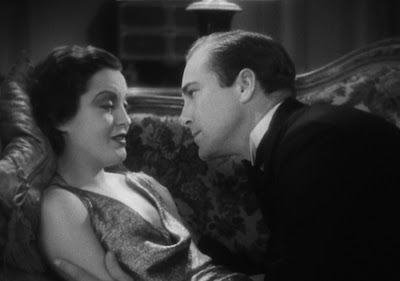Okay, I have plenty of atrocious material to work with here, so let's start with a classic to cleanse the palette before we move on to the really hardcore stuff. I present to you Carl Laemmle's
The Mummy, starring Boris Karloff (billed as "KARLOFF THE UNCANNY" in some of the promotional materials -- how awesome is that?) and Zita Johann, along with David Manners, Edward Van Sloan (best known for his role as Van Helsing in Universal Studios'
Dracula), and Arthur Byron.
Let me say this right off the bat -- I
love this movie. Like most of the classic Universal monster movies, it's dripping with atmosphere. The "monster" of this film is a delightfully complex character. The level of camp is perfect. The musical score is haunting. And you know what? All things considered, the Egyptology is not
that bad.
We're already off to a good start with the title cards:

We see lovingly detailed little model of the Giza plateau, with pyramids and sphinx -- one of the most instantly recognizable images of Ancient Egypt. At the time this movie came out, work was underway to excavate the sphinx, which had been partially buried under sand for thousands of years. The model shows the sphinx still shrouded in sand up to the chest. The camera pans around behind the pyramids to reveal the punchline to the text in the image above:

Now, that's just awesome. But then!

Do you see what's wrong with this picture? No? Take a closer look. The hieroglyphs are
upside-down. I have seen this movie far more times than I can count. How did I not notice this until now? For bonus hilarity, check out the cartouche in the second register there. It's flat on both ends, which is admittedly kind of adorable, but they're supposed to look like
this. You may notice that the example I just linked has one of the same symbols in it as our double-ended cartouche. That's the sign
ms (as in Ra-
mes-ses, or, in the case of the linked example, Thoth-
mes). I'm not sure what the other sign in there is supposed to be. A heqa scepter? Who knows. I've already spent way too much time analyzing this one frame, and there's still a whole movie to watch.
Okay, I'll let the rest of the credits pass in peace. They're playing that beautiful eerie music from Swan Lake, which was also the opening music for Dracula. Man, I love that.

Back-story time! That's actually a pretty nice copy of a scene from the Book of the Dead, probably the Papyrus of Ani, specifically. Although this is
not the "Scroll of Thoth", it is a magical/religious text that has to do with death, rebirth, and negotiating the afterlife, so they were at least in the right genre. And they didn't totally pull the Scroll of Thoth out of their asses, either. The Scroll of Thoth (and many of the story elements of this movie) comes from a Demotic literary text that also inspired Mika Waltari's
The Egyptian (don't worry, you'll hear more about that one later). It's one of the stories of Setna Khaemwaset, a son of Ramesses II who became a legendary figure in the centuries after his death. Anyway, I'm off on another tangent. Let's see what happens next!
Next we get a supposed excerpt from the scroll, telling us that "Death is but the doorway to new life -- We live today, we shall live again (. . .)" Okay, that's not entirely at odds with Egyptian beliefs, although they didn't really believe in reincarnation in the way that it's presented in this movie.
We start with some gorgeous establishing shots of Deir el Bahri. I don't know how much of this is stock footage and how much of this movie was actually shot in Egypt, but it's really cool to see some footage of actual locations. A lot of the movies I'm going to talk about here won't have that.
It's 1921, and the British Museum has a field expedition going . . . presumably on the west bank of Luxor. They've made an interesting find: a mummy buried in an intentionally damaged coffin, with a mysterious chest. Our stuffy, scientific-minded scholar, Sir Joseph Whemple (Arthur Byron), is trying to explain to his goofy young assistant (Bramwell Fletcher, in a performance worthy of Universal's usual go-to demented character actor, Dwight Frye) that the little finds are often actually the most important, and that archeology is not about sensation and treasure hunting.
Thank you, Sir Joseph Whemple!
But this is actually good Egyptology. I'm getting off-topic here! They establish that the mummy was buried alive, and that his coffin was defaced to remove the protective spells that would help him enter the afterlife. Okay, sure. Of course, if the Ancient Egyptians really had it in for someone, they probably wouldn't have bothered to wrap him up and stick him in a nice coffin. But then we wouldn't have a mummy, so I guess I'll give them that one. The mummy himself looks fantastic -- he actually bears a striking resemblance to the mummy of Ramesses III. Amazingly, the bit of text in his coffin that they read off actually says something (and it's not that far off from what Goofy Assistant tells us it says):

He reads "Imhotep, high priest of the temple of the sun at Karnak." It actually says "Imhotep, high priest of the temple (Hwt-nTr)" before it gets cut off. Not bad at all! But the hieroglyphs are backwards. Oops. Can't have everything, I suppose. Also, anyone trying to screw this guy over in the afterlife would not have left that information intact. Destruction of the name was one of the most damning things you could do to a person, along with destruction of the body.
Goofy Assistant speculates that he "got too gay with the vestal virgins in the temple". Van Hels-- er, Professor Muller agrees that this is a possibility. He explains that the virginal priestesses of Isis were daughters of the reigning pharaoh, and any hanky-panky would indeed have been frowned upon. This is . . . a somewhat garbled representation of what was going on in the late New Kingdom and especially in the Third Intermediate Period, when daughters of the king were in fact routinely installed as high priestesses of Amun at Karnak. Their celibacy is disputed by Egyptologists to this day. But our Imhotep, despite being named after a famous figure from the Old Kingdom, is supposed to hail from the 18th Dynasty (early New Kingdom), which is a little early for the situation that they are getting at here.
But Goofy Assistant has had enough of this historical background stuff. He wants to get into that box! It probably has shiny things in it!

That's right, fellas. You just tear apart that ancient linen like it's wrapping paper on Christmas morning. DON'T CHECK IT FOR DOCKETS OR TRY TO CONSERVE IT OR ANYTHING. *sobs*
Okay, the next part will cheer me up. This right here is my favorite.

"The unbroken seals of the pharaoh Amenophis!" exclaims Sir Joseph. (It becomes clear later in the movie the Amenophis in question is Amenhotep III.) Close, Sir Joseph, but no cigar! That top cartouche says "Akhenaten". You know, Amenophis' son. The one who changed his name and ran off and started a crazy new pseudo-monotheistic religion. The cartouche underneath says Nefer-kheper . . . something. I don't know what those last two signs are supposed to be. It should be Neferkheperure, if they were going to commit to this Akhenaten thing.
There's another box inside, with a curse on it (surprise!) that promises "eternal punishment" to anyone who opens the box. They show us a pretty nice shot of the glyphs as they read them, but I'm sad to report that these ones don't actually seem to say anything. Anyway, the cursed nesting boxes containing the magical scroll are an element right out of the story of Setna. For that matter, so is the living mummy. That's pretty cool.
Of course the wise and experienced older guys are completely freaked out by this curse, but Goofy Assistant is all raring to go. Sir Joseph doesn't really believe in the curse, but Dr. Muller, the resident occult expert, is all of a twitter. The older two issue a strict "don't touch" and head outside to talk it over, leaving G. A. alone with the box. I'm sure you can't imagine what happens next.

Yup.
This is actually, without a doubt, one of the most delicious scenes in early horror movie history. It's totally silent except for the soft hiss of the old film and the quiet sounds that G. A. makes as he goes about his work. No dialogue except for his almost inaudible murmuring as he translates the spell. And then, of course, his hysterical laughter when the mummy walks away with the scroll, trailing his dusty bandages behind him. The mummy himself is off-screen for most of this scene, although we see him open his eyes and we see his hand on the scroll.
The others hear the shrieks of laughter and come to see what's happened:

"H-he-he . . . went for a little walk! You should've seen his face! AHAHAHAHAHA!"
Man, I love Goofy Assistant. I kind of wish he was the main character.
The mummy and scroll are missing, the assistant has gone completely batshit, and there is a single dusty hand-print on the work table. A look of horror dawns on Sir Joseph's face, and we fade to black.
End of Act I, and Part I of this review. Stay tuned!





















